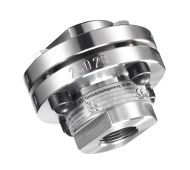| Purpose : To prevent the spread of an explosion.
Standards :
Notified bodies : IBExU & BAM |
Medium and explosion groups :
|
In line flame arrester with flanges : deflagration proof or detonation proof for unstable or stable detonation
| Application : Gas, air, vapors ; to stop the propagation of detonation
Materials :
Connection : DN25 to DN400 (1″ to 16″) Options :
Some other type of in line flame arresters may reach your need, feel free to contact us. |
 |
In line flame arresters with screwed ends : deflagration proof or detonation proof for unstable or stable detonation
In line detonationproof Flame-Arrester : 1002-0008
|
Stable detonation proof in line flame arrester Application : Explosion group IIB3 Description :
Some other type of in line flame arresters may reach your need, feel free to contact us. |
 |



